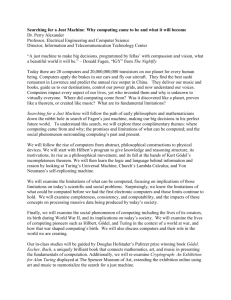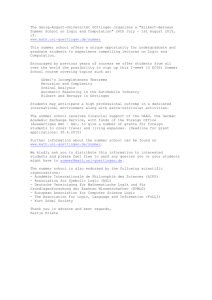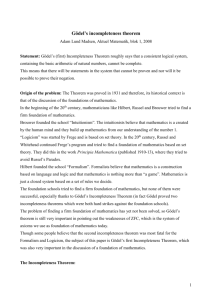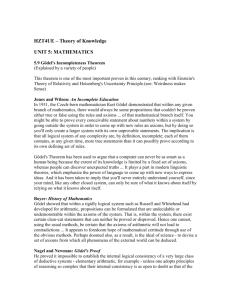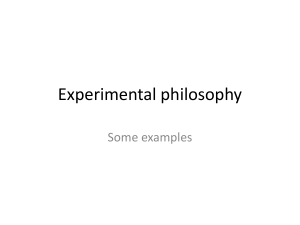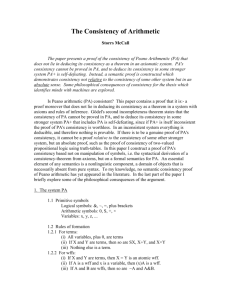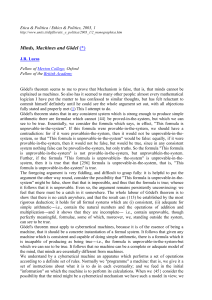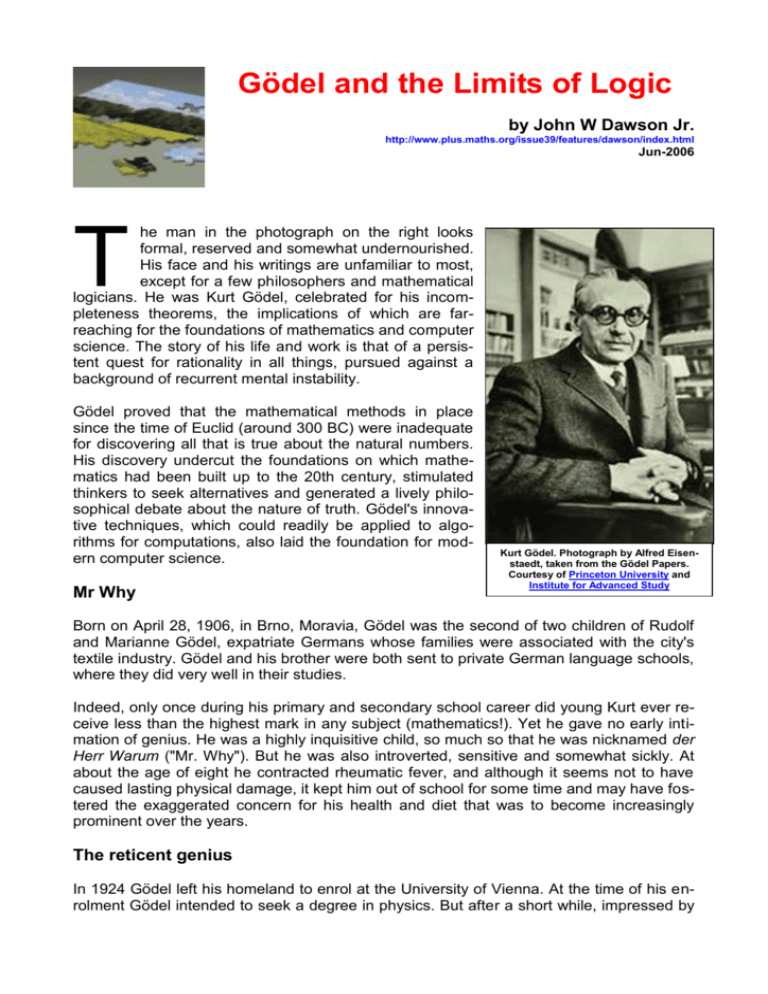
Gödel and the Limits of Logic
by John W Dawson Jr.
http://www.plus.maths.org/issue39/features/dawson/index.html
Jun-2006
T
he man in the photograph on the right looks
formal, reserved and somewhat undernourished.
His face and his writings are unfamiliar to most,
except for a few philosophers and mathematical
logicians. He was Kurt Gödel, celebrated for his incompleteness theorems, the implications of which are farreaching for the foundations of mathematics and computer
science. The story of his life and work is that of a persistent quest for rationality in all things, pursued against a
background of recurrent mental instability.
Gödel proved that the mathematical methods in place
since the time of Euclid (around 300 BC) were inadequate
for discovering all that is true about the natural numbers.
His discovery undercut the foundations on which mathematics had been built up to the 20th century, stimulated
thinkers to seek alternatives and generated a lively philosophical debate about the nature of truth. Gödel's innovative techniques, which could readily be applied to algorithms for computations, also laid the foundation for modern computer science.
Mr Why
Kurt Gödel. Photograph by Alfred Eisenstaedt, taken from the Gödel Papers.
Courtesy of Princeton University and
Institute for Advanced Study
Born on April 28, 1906, in Brno, Moravia, Gödel was the second of two children of Rudolf
and Marianne Gödel, expatriate Germans whose families were associated with the city's
textile industry. Gödel and his brother were both sent to private German language schools,
where they did very well in their studies.
Indeed, only once during his primary and secondary school career did young Kurt ever receive less than the highest mark in any subject (mathematics!). Yet he gave no early intimation of genius. He was a highly inquisitive child, so much so that he was nicknamed der
Herr Warum ("Mr. Why"). But he was also introverted, sensitive and somewhat sickly. At
about the age of eight he contracted rheumatic fever, and although it seems not to have
caused lasting physical damage, it kept him out of school for some time and may have fostered the exaggerated concern for his health and diet that was to become increasingly
prominent over the years.
The reticent genius
In 1924 Gödel left his homeland to enrol at the University of Vienna. At the time of his enrolment Gödel intended to seek a degree in physics. But after a short while, impressed by
2
the lectures of professors Philipp Furtwängler and Hans Hahn, he switched to mathematics. His remarkable talents soon attracted attention — so much so that just two years after
his matriculation he was invited to attend sessions of a discussion group that Hahn and
philosopher Moritz Schlick had founded two years earlier. The group, which was later to
become famous as the Vienna Circle, was inspired by the writings of Ernst Mach, a champion of rationalism who believed that all things could be explained by logic and empirical
observation, without recourse to metaphysics.
The Circle brought Gödel into contact
with scholars such as philosopher of
science Rudolf Carnap and mathematician Karl Menger and helped to acquaint him with the literature of mathematical logic and philosophy. In particular, the Circle was immersed in the
writings of Ludwig Wittgenstein, whose
concern about the extent to which language can speak about language may
have prompted Gödel to probe analogous questions about mathematics.
Gödel did not, however, share the
positivistic philosophical outlook of the
Circle, which extended Mach's ideas.
Instead he was a Platonist: he believed
that in addition to objects, there exists
a world of concepts to which humans
have access by intuition. For Plato,
Kurt Gödel (right) with his brother Rudolf around 1908.
who lived around 400 BC, concepts
Image courtesy J W Dawson.
such as truth were not products of the
human mind which can change according to the thinker's point of view, as some philosophers believe, but existed independently of the human observer. Thus, a statement could
have a definite "truth value" — be true or not — whether or not it had been proved or could
be empirically confirmed or refuted by humans. Gödel subscribed to this philosophy, and,
in his own view, this was an aid to his remarkable mathematical insights.
Although Gödel was an attentive observer and clearly brilliant, he rarely contributed to the
Circle's discussions, unless they were about mathematics. Shy and reclusive, he had few
close friends. (He did, however, like the company of women and was apparently quite attractive to them.) After 1928 he seldom attended the group's meetings but became active
instead in a mathematical colloquium organised by Menger.
Moment of impact
During this period, Gödel suddenly acquired international stature in mathematical logic.
Two papers in particular thrust him into prominence. One was his doctoral dissertation,
submitted to the University of Vienna in 1929 and published the next year. The other was
his treatise On Formally Undecidable Propositions of Principia Mathematica and Related
Systems, published in German in 1931 and submitted as his Habilitationsschrift (qualifying
dissertation for entrance into the teaching profession) in 1932.
3
The dissertation, entitled The Completeness
of the Axioms of the First-Order Functional
Calculus, solved an open problem that David
Hilbert and Wilhelm Ackermann had posed in
their 1928 textbook Grundzüge der theoretischen Logik (Foundations of Theoretical
Logic). The problem concerned formalised
mathematical systems and the accepted rules
for logical reasoning, which were stated in the
book.
A formalised mathematical system is described by a set of axioms. These are predetermined truths that define the objects in
the system and are never called into question.
The ancient mathematician Euclid, for example, based his theory of plane geometry on
five axioms. The statements "any two points can be joined by a straight line segment" (fig
1), and "any straight line segment can be extended indefinitely" (fig 2), are two of these
axioms.
They are taken to be true from the outset, and
any other statement about plane geometry
has to be derived from the five axioms using
only the rules of logic — no intuition or
knowledge that comes from outside the system are allowed.
Hilbert and Ackermann's question was: if you
have a set of axioms describing a mathematical system, do the rules for logical reasoning
which they gave in their book allow you to derive every true statement about the system,
and do they ensure that only true statements
can be derived?
Euclid's five axioms for plane geometry
— read more in the Plus article The origins of proof.
The expected answer was "yes", and Gödel
confirmed that it was. His dissertation established that the principles of logic developed up
to that time were adequate for their intended purpose, which was to prove everything that
was true on the basis of a given set of axioms. It did not show, however, that every true
statement concerning the natural numbers, that is the numbers 0,1,2, ... , could be proved
on the basis of the accepted axioms of number theory.
The problem with number theory
The axioms of number theory were based on those laid out by the Italian mathematician
Giuseppe Peano in 1889. The first four of his axioms are
0 is a natural number,
every natural number has a successor,
no natural number has 0 as its successor,
distinct natural numbers have distinct successors.
4
The successor of 0 is what we call 1, the successor of 1 is what we call 2, etc. In this way,
all the natural numbers are defined, and so is the operation of addition: 16+4, for example
means "take the number 16 and move on 4 places in the sequence of successors".
The fifth and final of Peano's axioms is known as the principle of induction, and this axiom
proved to be the sticking point. It states:
Suppose that a property holds for 0, and suppose you can prove that if this property holds
for another natural number, then it also holds for the successor of that number. Then the
property holds for all natural numbers.
This is sometimes called the domino
principle: if you knock one over, the rest
will topple. It might seem self-evident,
but mathematicians found it problematic,
because rather than talking about natural numbers themselves, it talks about
properties of natural numbers. Such a
"second-order" statement was thought
too vague and ill defined to serve as a
basis for the theory of natural numbers.
A simple proof by induction
We will prove by induction that
0 + 1 + 2 + 3 + .... + n = n(n+1)/2
for any positive whole number n.
First, we verify that the statement is true for n = 0:
0 = (0 × 1)/2,
so it is.
To circumvent that problem, the induction axiom was translated into an infinite
schema of similar axioms that refer to
specific formulas rather than to general
properties of numbers. Unfortunately,
however, those axioms no longer
uniquely characterize the natural numbers. Indeed, as Norwegian logician
Thoralf Skolem demonstrated a few
years after Gödel's work, even if all
statements that are true of the natural
numbers are taken as axioms, there will
still be other structures, essentially different from the natural numbers, that also satisfy the axioms.
Now we assume that the statement is true for a positive whole number k and see if we can show that it
is also true for k+1:
1 + 2 + ... + k + k+1
= k(k+1)/2 + k+1
= (k(k+1)+2k+2)/2 = (k2+3k+2)/2
= (k+1)(k+2)/2.
Thus, whenever the statement is true for a number
k, it is also true for k+1, the next number along.
So, since we have verified the statement for 0, it follows that it must be true for 1, which means it must
be true for 2 and in turn for 3, etc. We can reach any
positive whole number n in this way, so we have
proved that the statement is true for all positive
whole numbers, as required. QED
Now Gödel's completeness theorem
states that whatever propositions are
taken as axioms, one can prove all (and
only) those statements that hold in all structures satisfying the axioms. But if some statement is true of the natural numbers but is not true of another system of entities that also
satisfies the axioms, then it cannot be proved. At first, that did not seem to be a serious
problem, because mathematicians hoped that entities that masqueraded as numbers but
were essentially different from them did not exist. So Gödel's next theorem came as a
shock.
The Incompleteness Theorem
In his 1931 paper Gödel showed that, no matter how you formulate the axioms for number
theory, there will always be some statement that is true of the natural numbers, but that
5
can't be proved. (That is, objects that obey the axioms of number theory but fail to behave
like the natural numbers in some other respects do exist.)
But why not just turn such a true but unprovable statement into an axiom? After all, axioms
are precisely those statements which we accept to be true without proof. But here lies the
true bite of the incompleteness theorem: Gödel showed that whenever the axioms can be
characterized by a set of mechanical rules, it does not matter which statements are taken
to be axioms: some other true statements about the natural numbers will remain unprovable. It's like an ill-designed jigsaw puzzle. No matter how you arrange the pieces, you'll always end up with some that won't fit in the end.
The incomplete puzzle of the natural numbers: no
matter what you try, some pieces will never fit.
Although Gödel's work irrefutably proves that "undecidable" statements do exist within
number theory, not many examples of such statements have been found. One example
comes from the sentence:
This statement is unprovable
You can see why this is a prime candidate: if you could prove this statement to be true,
then it would be false! It is true only if it is unprovable, and unprovable only if it is true. As it
stands, this is not a statement about the natural numbers. But Gödel had devised an ingenious way to assign numbers to English-language phrases like this one, so that finding
whether the statement is true or not translates to solving numerical equations. He proved
that, within the axioms of number theory, it is impossible to prove whether or not the equation corresponding to the sentence above holds true, thus confirming our "common-sense"
analysis.
In a similar way, Gödel translated the statement
6
The axioms of this theory do not contradict each other
into numerical code, and again proved that the translation is unprovable. Any proof that the
axioms do not contradict each other — that they are consistent — must therefore appeal to
stronger principles than the axioms themselves.
The latter result greatly dismayed David Hilbert, who had envisioned a program for securing the foundations of mathematics through a "bootstrapping" process, by which the consistency of complex mathematical theories could be derived from that of simpler, more evident theories. Gödel, on the other hand, saw his incompleteness theorems not as demonstrating the inadequacy of the axiomatic method but as showing that the derivation of theorems cannot be completely mechanized. He believed they justified the role of intuition in
mathematical research.
The concepts and methods Gödel introduced in his incompleteness paper are central to all
of modern computer science. This is not surprising, since computers are forced to use logical rules mechanically without recourse to intuition or a "birds-eye view" that allows them
to see the systems they are using from the outside. Extensions of Gödel's ideas have allowed the derivation of several results about the limits of computational procedures. One is
the unsolvability of the halting problem. If you have ever written a computer program, you
will know that a programming mistake can cause it to enter an infinite loop: it will run forever and never end. The question is if there can be an algorithm that can examine any
computer program and decide whether it will eventually halt or whether it will keep running
forever. This is the halting problem and the answer is "no".
Another result that derives from Gödel's ideas is the demonstration that no program that
does not alter a computer's operating system can detect all programs that do. In other
words, no program can find all the viruses on your computer, unless it interferes with and
alters the operating system.
He's behind you!
No program can find all the viruses on your computer,
unless it interferes with the operating system itself.
7
Matters of heart and mind
Gödel spent the 1933-34 academic year in Princeton, New Jersey, at the newly founded
Institute for Advanced Study, where he lectured on his incompleteness results. He was invited to come there the next year as well but suffered a mental breakdown shortly after his
return to Vienna. He recovered in time to return to Princeton in the fall of 1935, but a
month after his arrival he experienced a relapse and did not return to lecturing until the
spring of 1937 in Vienna.
His problems seem to have started with hypochondria: he was obsessive about his diet
and bowel habits and kept a daily record for two decades or more of his body temperature
and milk of magnesia consumption. He had a fear of accidental and, in later years, deliberate poisoning. This phobia led him to avoid eating food, so that he became malnourished. At the same time, though, he ingested a variety of pills for an imaginary heart problem.
Except in times of crisis, Gödel's mental problems
hampered his work surprisingly little. The person
who kept him going was Adele Porkert, whom he
had met at a Viennese nightclub during his student
years. Porkert was a Catholic divorcée six years
older than Gödel, who worked as a dancer and
whose face was disfigured by a birthmark. His
parents regarded her as a scandalous person. But
the two were devoted to each other, and more
than once, by serving as his food taster, she
helped to allay Gödel's growing fears that someone was trying to poison him. The two were married in September 1938, just before Gödel returned once more to America.
Back in the states, Gödel lectured at the Institute
for Advanced Study and the University of Notre
Dame on exciting new results in set theory, which
Kurt Gödel and his wife, Adele.
answered another question of Hilbert's. These rePhotograph by Oskar Morgenstern.
sults represented another major achievement, but
Courtesy of the Archives of the
Institute for Advanced Study.
they were still not enough to earn him a permanent academic position. During his year at the Institute for Advanced Study and Notre
Dame, his authorization to teach at Austrian universities lapsed. When he returned to Vienna to be reunited with his wife in the summer of 1939, he was summoned for a military
physical and declared fit for service in the Nazi armed forces.
Shelter in America
Until then, Gödel appears to have been aloof to the frightening developments in Europe.
His lack of emotional engagement with people may have kept him from appreciating the
significance of what was happening. He seemed oblivious to the fates befalling his colleagues and professors, many of whom were Jewish: he stayed immersed in his work
while the world around him fell apart. Finally, he realized it was taking him down as well.
8
In that desperate situation he enlisted the support of the Institute for Advanced Study to
help secure exit visas for himself and his wife. His efforts were successful, and in January
1940 the two of them began a long journey to Princeton.
Gödel never again left the
U.S. He was made a permanent member of the institute
faculty in 1946. Two years
later he acquired American
citizenship (on which occasion the judge who swore him
in made the unfortunate error
of asking his opinion of the
U.S. Constitution, and thereby
unleashed a pent-up lecture
on its inconsistencies.) But
Gödel was not promoted to
professor until 1953 — the
same year he was elected to
membership in the National
Kurt Gödel and Albert Einstein.
Photographed by Oskar Morgenstern.
Academy of Sciences — in
Courtesy of the Archives of the Institute for Advanced Study
part because his expressed
fear that poison gases were escaping from his refrigerator aroused continuing concern
about his mental stability. During those years, his friend Albert Einstein took it on himself to
look after Gödel as best he could, taking a walk with him every day. Their conversations
seem to have had a calming effect on Gödel.
After his emigration Gödel turned to philosophy and relativity theory. In 1949 he demonstrated that universes in which time travel into the past is possible were compatible with
Einstein's equations.
Deepening fears
Gödel's last published paper appeared in 1958. After that he withdrew more and more into
himself, becoming increasingly emaciated, paranoid and hypochondriacal. He last appeared in public in 1972, when the Rockefeller University granted him an honorary doctorate. Three years later he was awarded the National Medal of Science but declined to attend the awards ceremony on grounds of ill health.
On July 1, 1976, having reached the mandatory retirement age of 70, Gödel became professor emeritus at the institute. His responsibilities did not lessen, though, because his
wife, who for so many years had nurtured and protected him, had suffered an incapacitating stroke a few months before. It was his turn to care for her. He did so, devotedly, until
July 1977, when she underwent emergency surgery and was hospitalized for nearly six
months.
At about that time Oskar Morgenstern, the friend who had helped to look after Gödel in the
years after Einstein's death in 1955, died of cancer. Gödel was thus left to fend for himself
against his growing paranoia. In the face of that, he declined rapidly. His fear of poisoning
led to self-starvation, from which he died on January 14, 1978.
9
Adele Gödel survived her husband by three years. At her death, on February 4, 1981, she
bequeathed rights to Gödel's papers to the Institute for Advanced Study.
Gödel published remarkably few papers during his lifetime, but their impact has been
enormous. They have affected virtually every branch of modern logic. During the past decade, other papers of his have been translated and published posthumously in the third volume of his Collected Works. Their contents, including his formalization of the so-called ontological argument for the existence of God, have now begun to attract attention as well. At
last, the breadth of his work is becoming known to those outside the mathematical community.
Further reading
Read more about mathematical proof in past Plus articles, including our series on
the origins of proof from Euclid to Gödel to the proof of Fermat's Last Theorem.
About this article
This article was adapted from Gödel and the limits of logic
by JW Dawson. Copyright © June 1999 by Scientific American, Inc. All rights reserved.
John W Dawson is Professor of Mathematics at the York
campus of Pennsylvania State University. Trained as a logician, during the years 1982-84 he catalogued Gödel's papers at the Institute for Advanced Study, work that provided
the basis for his 1997 biography Logical Dilemmas: The Life
and Work of Kurt Gödel.
Dawson's book Logical dilemmas: The life and work of Kurt
Gödel is reviewed in this issue of Plus.

